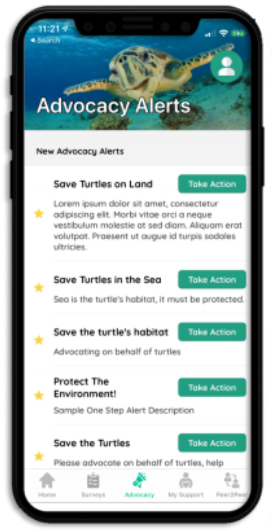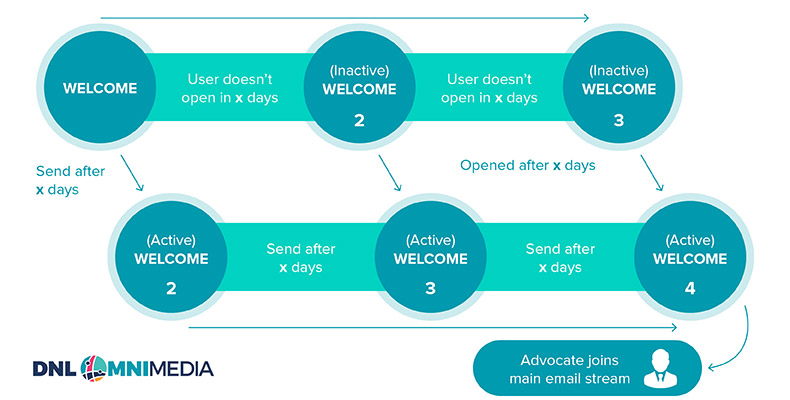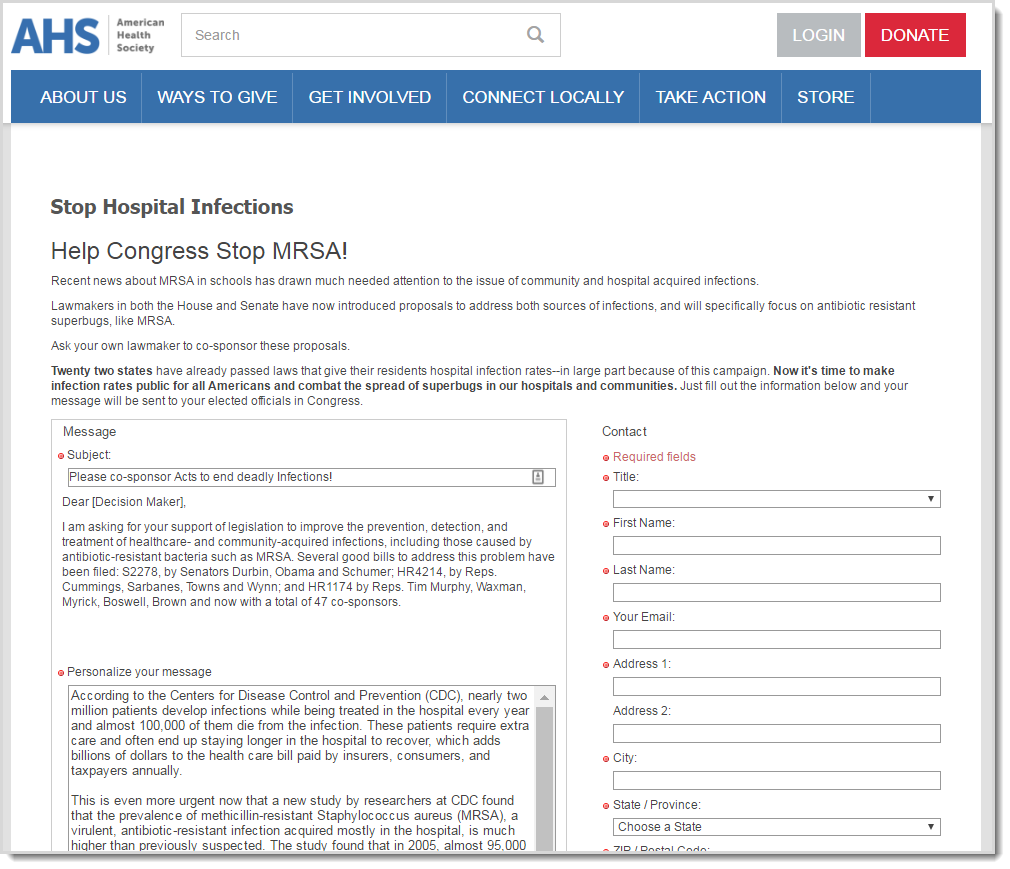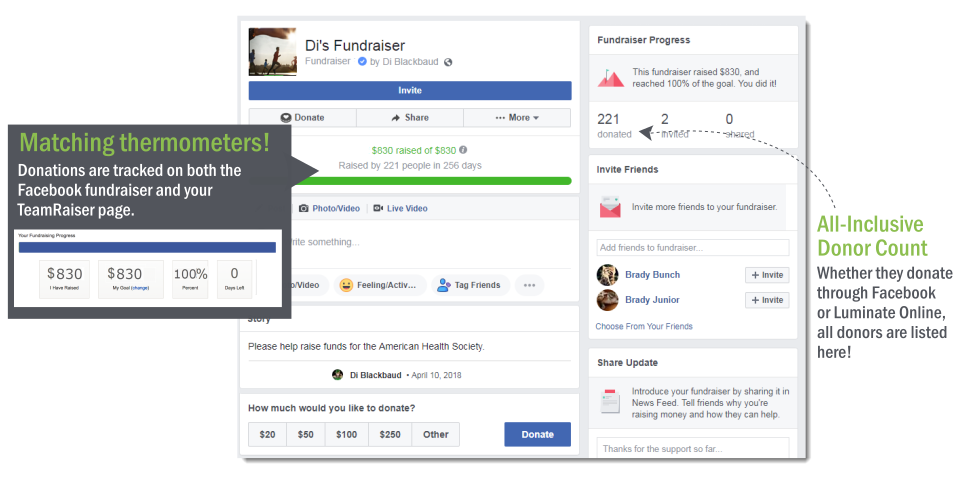For advocacy-focused organizations, having a strategic online marketing and fundraising approach is a must. Not only can a smart digital advocacy plan help you engage with supporters through channels like email and social media, but it can also put your cause in front of a wide network of people who might not have known about your organization otherwise.
If you’re looking to hone your digital advocacy strategy, top-tier advocacy software like Luminate Advocacy, the Luminate Online Marketing module built for grassroots campaigns, can help.
Advocacy technology solutions can centralize your various campaign efforts, from marketing and outreach all the way to accepting online donations or getting signatures on your latest petition, and make it easier to keep track of your campaign progress.
To help you use your software more strategically and get the most from your advocacy campaign, we’ve got 7 digital advocacy tips for nonprofits just like you:
- Create a multi-channel digital advocacy approach.
- Welcome your new advocates with an automated email series.
- Target your digital advocacy outreach to each supporter.
- Create relevant action alerts that tie into current events.
- Equip and train your grassroots advocates for digital success.
- Promote fundraising opportunities in your digital advocacy campaigns.
- Measure your digital advocacy campaign success.
We know that digital fundraising strategies are only becoming more vital to nonprofits. In fact, over half of the individuals who engage with nonprofits via social media are likely to take some sort of action to support that cause, either through donating, signing up to volunteer, or contacting a legislator or representative. And that’s just one online channel!
To learn how to maximize all of your online efforts during your grassroots campaigns, keep reading.

1. Create a multi-channel digital advocacy approach.
Digital advocacy can encompass almost any number of online communication channels and digital outreach methods.
That being the case, the best online advocacy campaigns don’t just stick to one digital advocacy tactic. Rather, smart strategists acknowledge that there’s a wide variety of ways to get in touch with advocates online and capitalize on as many as they can!
To start mapping out what your online approach will be, assess the following popular mediums to determine where your advocacy campaign might fit in:
 Mobile Apps
Mobile Apps
With DNL OmniMedia and Luminate Online, you can invest in a custom, fully branded mobile application that builds on the Luminate Advocacy platform, giving you the opportunity to connect with supporters wherever they may be. Learn more about the MobileAction! app from DNL OmniMedia here.
Not only is this a great strategy for boosting engagement, but it also creates a strong impression of your organization as professional and in-touch.
Email Strategies
Even with the rise of newer digital marketing strategies, email remains an extremely effective, and (most importantly) direct way to reach your supporters. Nearly everyone has at least one email address they check daily, making email a perfect channel for getting the word out.
You can send emails to everyone in your supporter list or take a more targeted approach by creating segments that correspond to different subsets of supporters.
Social Media Techniques
Want to put your cause in front of thousands of potential new supporters at once? Social media is the tool for you. These platforms are perfect for emotionally compelling and socially relevant causes since they encourage quick engagement and sharing among supporters.
With so many different platforms (all with different functionalities), you’ll have to do some trial and error research to figure out what content works best for your audience. Find out which platforms they already use, and start by focusing your efforts there.
Your Website
Your nonprofit’s website should house all the most important details about your cause, so don’t overlook it as a means of connecting with supporters! Whether you’re using Luminate CMS or another site builder, make sure your pages are optimized to educate visitors about your advocacy campaign and drive them to action.
Your website should serve as a central hub for your marketing efforts. Use your other communication outlets to continually drive traffic and engagement to your site.
Worried you won’t be able to stay on top of so many moving parts in your nonprofit digital marketing strategy? Don’t be!
With Luminate Online, you’ll gain access to a wide range of digital marketing features, including email campaign management and segmentation tools, social media engagement tracking, website content management, and more. Learn more about what you can do with Luminate Online by reading our in-depth guide!

2. Welcome new supporters with an automated email stream.
When it comes to supporter engagement, you don’t want to waste any time. An email stream targeted toward welcoming new supporters can be an inviting way to educate them about your organization and get them involved from the moment they sign up.
You can automate the series so that it’s instantly sent to anyone who joins your mailing list, signs a petition, downloads an advocacy resource, or takes another action on your site or social media pages. Configure different streams of emails targeted to recipients based on how they initially interacted with you and how engaged they’ve been with your previous emails.
Here’s a rough example of a typical email stream you might use to welcome new supporters to your advocacy campaign:

Thanks to automation tools, you don’t have to manually send out every single email; you can write up all the content at once and schedule it to send on a weekly, bi-weekly, or even daily schedule.
When drafting your welcome packet content, keep these tips in mind:
- Address each supporter by their first name. As long as you collect first names on your online forms, you can pre-configure your emails to include personalized greeting rather than a generic “Dear Friend.”
- Provide new information about your cause in each message. You’ll want your emails to be brief, but make sure they’re meaningful, too. Each email should educate your new supporters in a more in-depth way than your website or social posts could.
- Include calls-to-action where relevant. If you’re posting regular blogs or educational content on your website, place buttons at the end of your emails to link to these posts. Or, invite new supporters to join online membership pages, sign up for action alerts, or download your app.
- Mobile optimize your content. Luminate Online’s email tools should make your messages readable on any screen size, but it’s always a good idea to keep your design minimal (i.e., one or two columns, no excess images or clutter) and to test each email on a mobile device before scheduling.
You can use even these emails to gather information about your new supporters. Consider devoting one of your emails to sending a “Getting to Know You” survey where you can collect data like:
- Preferred name and title.
- Contact information.
- Campaign interests (i.e., volunteering, social media advocacy, peer-to-peer fundraising).
- Social media handles.
- Previous advocacy/volunteer/job experience.
Since these questions are optional, you won’t risk deterring a new supporter like you might if you included these questions in a sign-up form.
Make sure that all the data you capture is filed correctly in your Luminate database or CRM so that you can actually use it to plan out how you communicate with each individual. Which brings us to our next point…

3. Target your digital advocacy outreach to each supporter.
Advocacy campaigns rely on a number of different types of support, from volunteers at your big event to donors to social media ambassadors and much more. 
Each of your constituents brings something unique to the table, and it’s up to you to make sure you’re sending the best opportunities their way to utilize those strengths and interests.
The first step to using that data is, of course, to collect it through surveys or other means of communication. Once you know what your supporters’ preferences and interests are, here are just a few ways you can tap into that knowledge:
- Create email lists based on interest categories. Segment your database so that supporters are only receiving updates on the areas that interest them. For example, you can send weekly volunteer opportunities to those who have expressed interest in lending a hand as a volunteer, but you might send a different message to those who prefer creating online content (like blogs or videos) to promote your cause.
- Target action alerts by geographic location. Particularly important for political advocacy campaigns, knowing where your supporters are in the world can help you send the most relevant action requests. If you’re asking supporters to reach out to a senator, for example, you can include that lawmaker’s exact information within the alert so there are no extra steps for the supporter.
- Reference past involvement. Your supporters don’t want their effort to go unnoticed, and recognizing past involvement in your communications can guarantee that doesn’t happen. When asking for a donation or volunteer help, make sure you remind them what their previous help has accomplished.
The more specific your advocacy outreach can be, the more likely your supporters are to want to get involved—and stay involved.
Remember: none of these tactics will be very useful if you don’t have the data on hand to back them up. Keep your Luminate database clean and up-to-date so you always have real-time insight into who your advocates are and what they’re looking for from your campaign.

4. Create relevant action alerts that tie into current events.
Advocacy campaigns are especially connected to current events.
After all, your organization is seeking to effect some kind of change in the local, national, or international community, and it’s important to tie those efforts into current happenings within that community to remind supporters why your campaign matters.
Action alerts created within Luminate Online are the perfect opportunity to use current events to your advantage.
You can program action alerts to appear whenever a user lands on your website or send them straight to supporters via text message, email, or a notification through your mobile app.
A few examples of time-sensitive alerts include:
- Contacting a legislator prior to voting on an issue that relates to your cause.
- Signing a petition that promotes or opposes a recent judicial ruling, government or other institutional policy, or another timely event.
- Pledging to donate or volunteer in response to a natural disaster or other widespread occurrences.
- Starting a peer-to-peer fundraiser in honor of a national holiday or another date that is special for your cause (e.g., an Awareness Month or Day of Remembrance).
The benefit of action alerts is that they can be completely customized to inspire the action your cause needs. When a user opens the alert, they can be taken to an online form, a prewritten email, letter-to-the-editor tool, or call script.
Here’s an example action alert related to healthcare advocacy. Congress began debating legislation that would require greater transparency around infection rates, which triggered this action alert:

No matter what you’re motivating supporters to do, make sure that your action alert concisely explains both the need and the action requested. If you don’t communicate why this action is important or how they can take part, even the most invested supporters might gloss over the alert or abandon the action midway through.

5. Equip and train your grassroots advocates for digital success.
Your advocacy campaign may have been started by your organization, but its success lies in the hands of your supporters.
With the help of your software, make sure that your supporters are as empowered as possible to take up the challenge of spreading awareness and raising funds for your grassroots campaign.
No matter how excited an individual is about your cause, you can’t send them off to advocate for your cause without first providing them with the resources and guidance they need to succeed. Make it easier for your grassroots advocates to get involved and stay motivated by:
- Showcasing social sharing features. Enable supporters to quickly send ecards, send tell-a-friend messages, or share actions on social media to get their own networks involved in the cause. If you’re using a mobile app, you can even enable users to send messages to their phone contacts!
- Providing easy-to-modify templates. Often, supporters abandon actions like a letter to the editor or call/email to a legislator due to fear that they’ll say the wrong thing or won’t know what to say at all. You can abate those concerns by creating customizable templates for any action a supporter might take so they can act quickly and confidently.
- Hosting advocacy training sessions. If you’re launching a more intensive advocacy campaign that requires more complex actions (such as hosting grassroots fundraising events, speaking to lawmakers one-on-one, or leading local advocacy groups), you can offer group training classes in-person or online to answer any questions and provide materials for these “super advocates.”
- Providing educational resources on your website. Always keep your supporters educated about your advocacy campaign so they feel confident about spreading the word. Provide one-pagers and infographics that that detail the most important talking points for your cause as well as more in-depth articles on your website for supporters to reference.
While you don’t want to micro-manage your hardworking advocates, remember that your core team should be the guiding force for your campaign’s overall vision and techniques.
Developing a comprehensive plan that takes multiple moving parts into consideration is always a major challenge, but keeping your team focused on the big picture is the best way to maintain energy. Explore our guide to developing a digital strategy for all the essential elements of any nonprofit marketing or fundraising project.
For your volunteer advocates, always be available to answer any questions and clearly communicate your campaign’s big-picture goals. Provide contact information for a representative (preferably someone local, if your organization has multiple chapters) in case a supporter needs more information.

6. Promote fundraising opportunities in your digital advocacy campaigns.
As you should know by now, Luminate Advocacy is only one small part of the Luminate suite. With its full range of functions, your team can use the software to manage other aspects of your online campaigns—notably, online fundraising.
Though your advocates are already giving to your cause by donating their time, voices, and other talents, you’re missing out on a major opportunity if you don’t nurture these individuals into donors who contribute financially to your cause.
Remember, there’s more than one way to turn an advocate into a donor! In fact, simply sending a blanket solicitation might do more harm than good if you don’t acknowledge that each supporter should be individually stewarded and given plenty of giving options that are convenient and engaging.
Instead of sending a mass “Please donate!” email or social media post, try a more intentional solicitation approach. For example:
- Prioritize recurring gifts. If a supporter is willing to give once, they might be willing to give again! Make it easier by allowing them to opt-in to monthly giving on your online giving form. You can even include more information on why recurring gifts are so important or show examples of what each donation will provide on your donation page.
- Educate donors on corporate giving programs. Corporate philanthropy programs like matching gifts can double a supporter’s impact with little-to-no extra work. Include a matching gift or corporate giving page on your website and reach out to donors with information about how these programs work! (Hint: Double the Donation can be your go-to matching gift expert if you need some help along the way.)
- Try peer-to-peer fundraising. With Luminate Online and TeamRaiser, you can enable donors to take the reins by raising money on behalf of your organization through peer-to-peer fundraising. You can even customize your TeamRaiser experience to allow supporters to host their own unique campaigns that are tied to specific days, such as a birthday or holiday.

If an advocate isn’t quite ready to make a financial gift, don’t give up! Keep track of their other forms of involvement within your database and use them as a jumping off point for your next solicitation.
Using your software to track prospect status and giving history will make it easier to create strategic (and successful!) solicitations, so lean on Luminate as you outline your next steps. Take advantage of all your tools to help boost your stewardship efforts all around!

7. Measure your digital advocacy campaign success.
There’s no such thing as a perfect grassroots fundraising and advocacy campaign, but by setting clear goals and measuring your progress against them, you can get closer than ever to true success on your own terms. 
Thankfully, Luminate Online makes it easier than ever to create comprehensive reports and see dynamic visualizations of your progress. That way, you can track your results throughout your campaign and assess ways to improve your next initiative.
For a few examples of metrics to track, try the following:
- Survey results after your campaign vs. before.
- The number of new recruits in your advocacy campaign.
- The number of actions taken broken out by category (e.g., social media posts, petition signatures, calls to elected officials).
- Amount of local grassroots events held (and the number of attendees by region).
- Peer-to-peer fundraisers and donations to each.
- Social media followers, impressions, and engagements.
- Donations (including the dollar amount raised and the number of gifts given).
Of course, the metrics you track should correspond to the goals you set at the start of each campaign or, for ongoing campaigns, quarter or year.
If you find that you’re hitting or exceeding your goals, celebrate by creating even more ambitious goals for next time around!
If you’re falling short somewhere along the way, view your Luminate reports to find out how to course correct in the most effective ways. Team DNL can also help analyze and provide recommendations to improve your next campaign. You may come to find that a quick change midway through your campaign (for example, focusing on events in a specific region rather than spending resources in less popular areas) can save you in the long run.
Now that you know how to outline a stellar digital advocacy campaign, all that’s left to do is get online and start engaging your supporters. Good luck!
For more on how advocacy and technology intersect, check out these resources:
- Blackbaud CRM Guide. Luminate Online can integrate with your CRM solution so that all data is centrally stored and easy to access for your advocacy campaign. See which Blackbaud constituent relationship management product might be the best for you by reading our essential guide!
- Top Blackbaud Training Resources. Make sure you’re ready to use Luminate Online and Luminate Advocacy by checking out these top-notch training resources. We break down your training options to help you find the best solution for your team.
- Strategies for Maximizing Google AdWords Grants. Getting people to see your advocacy campaign will require a fool-proof marketing strategy. Learn about how to manage your Google AdWords grant to promote your organization and your cause.
- The Ultimate Guide to Advocacy. Learn absolutely everything about advocacy campaigns in this guide from Double the Donation. They’ll provide an in-depth definition of what advocacy is (and isn’t) and show you some best practices for launching your campaign, too.



